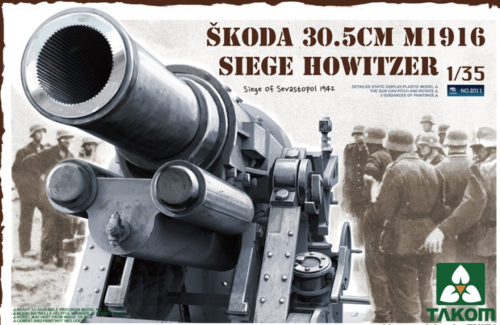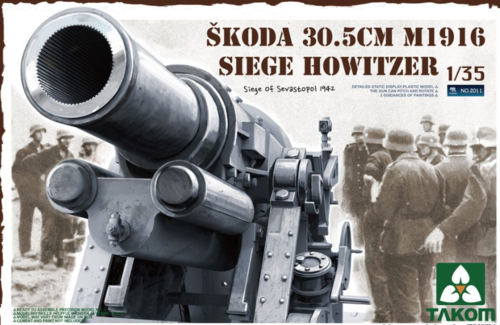Takom 1:35 Skoda 30.5cm M1916 Siege Howitzer
Takom 1:35 Skoda 30.5cm M1916 Siege Howitzer is backordered and will ship as soon as it is back in stock.
Couldn't load pickup availability
Delivery and Shipping
Delivery and Shipping
We use tracked courier for fast delivery New Zealand wide
Description
Description
The Skoda 305mm Model 1911 is a heavy howitzer (or heavy siege mortar) designed and built at the Skoda World War I plant. The first prototypes of the guns were built around 1910, and series production continued in the years 1911-1917 / 1918, ending with the production of about 80 examples of this weapon. The maximum range was 11,300 m, and the initial velocity of the projectile - 340 m / s. The rate of fire was up to 10 shots per hour. The Skoda 305 mm fired shells weighing 287 kg and 384 kg.
The Skoda 305 mm was designed to destroy concrete and armored fortifications. During World War I, it was also used to fight enemy artillery and attack earth fortifications. Unlike many heavy guns of that time, the Skoda 305 mm had considerable mobility - for a howitzer of this caliber - thanks to a properly developed tow truck and a special tractor dedicated to this weapon. Moreover, setting the gun into position took usually from 2 to 3 hours, which was a good result by the standards of World War I. Three variants of the Skoda 305 mm were created. The first one, marked as M11, was the first production version. The second - M11 / 16 - had a more solid construction, as a result of which the weight of the weapon increased. The last version of the M16 or M17 was characterized by an elongated barrel and a different location of the retractors. The weapon was intensively used by the Austro-Hungarian army during World War I, especially on the Italian and Carpathian fronts. They were also used in 1914 against the fortresses of Liege and Namur on the Western Front. In World War II, they were used, among others, by the German army to fire on the Maginot Line in 1940 and during the battles near Sevastopol in 1941-1942.
The Skoda 305mm Model 1911 is a heavy howitzer (or heavy siege mortar) designed and built at the Skoda World War I plant. The first prototypes of the guns were built around 1910, and series production continued in the years 1911-1917 / 1918, ending with the production of about 80 examples of this weapon. The maximum range was 11,300 m, and the initial velocity of the projectile - 340 m / s. The rate of fire was up to 10 shots per hour. The Skoda 305 mm fired shells weighing 287 kg and 384 kg.
The Skoda 305 mm was designed to destroy concrete and armored fortifications. During World War I, it was also used to fight enemy artillery and attack earth fortifications. Unlike many heavy guns of that time, the Skoda 305 mm had considerable mobility - for a howitzer of this caliber - thanks to a properly developed tow truck and a special tractor dedicated to this weapon. Moreover, setting the gun into position took usually from 2 to 3 hours, which was a good result by the standards of World War I. Three variants of the Skoda 305 mm were created. The first one, marked as M11, was the first production version. The second - M11 / 16 - had a more solid construction, as a result of which the weight of the weapon increased. The last version of the M16 or M17 was characterized by an elongated barrel and a different location of the retractors. The weapon was intensively used by the Austro-Hungarian army during World War I, especially on the Italian and Carpathian fronts. They were also used in 1914 against the fortresses of Liege and Namur on the Western Front. In World War II, they were used, among others, by the German army to fire on the Maginot Line in 1940 and during the battles near Sevastopol in 1941-1942.
Payment & Security
Payment methods
Your payment information is processed securely. We do not store credit card details nor have access to your credit card information.




